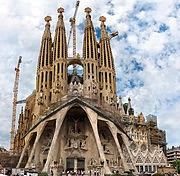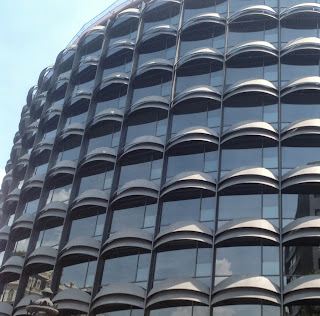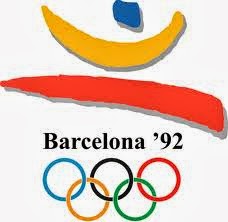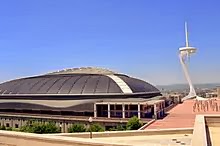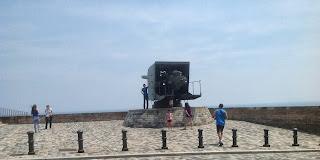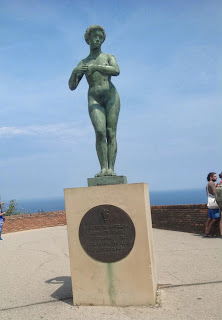 |
| Mary in Barcelona! |
We arrived in Barcelona welcoming a chance to speak a new language! We waited for our floor to be called to disembark the ship. Everything is done in an orderly manner with so many people having to leave the ship at one time. So we waited as we planned what we were going to do in this great city.
I have been here the year before and was eager to show John the sights. There was the
Sagrada Familia Basilica, the
Park Guell, and the
Montserrat Monastery on the hill. We had planned to stay the night in Barcelona and have tomorrow for sight seeing. On this day of depending on how much time we had left after disembarking, we planned the afternoon for touring the city. We decided the Montserrat Monastery would be a day trip, and we could spend the morning at the basilica and then maybe we would have some time for the beach in the afternoon. John perked up with this idea especially being the end of our trip, relaxing on the beach would be great!
So while we waited to have our number called, I did some research on Barcelona. The name is attributed to Hannibal's father Hamilcar Barca who named the town
Barcino. In 15 BC the Romans invaded setting up a military outpost, and called the city
Faventia. They set up the typical Roman grid for streets which can still be seen in the Gothic Quarter. After the fall of Rome the Visigoths moved in, and made it the capital of all Hispania. The Arabs conquer most of the Iberian peninsula in the 8th century, but the eastern region was reclaimed by Charlemagne's son Louis and he set up the area as a buffer zone ruled by the Count of Barcelona. As time went on, this area became increasingly independent included the area called Catalonia bordered by the Pyrenees and south near Valencia. It developed its own language which sounds somewhat like French.
Catalonia joined the Crown of Aragon through marriage and became a conquering force acquiring Naples and Sicily. With its success it created a banking system that is recognized as the oldest in Europe. Again through the marriage of Ferdinand II of Aragon and Isabella of Castille in 1469, the area became the northern part of Spain moving the seat of government to Madrid. Throughout history, however, Barcelona has always been the the seat of Catalan separatism movement due to its independent nature. This spirit was apparent during the Spanish Civil War and the anarchist held on the to city until they lost control to government troupes. This caused a mas exodus of civilians who fled to the French border. The government led by Franco abolished the Catalan language and Catalonian institutions. The Nazis never entered Spain, perhaps because Spain had a different guage for their train lines, or because Hitler was a friend of Franco. We can be thankful for this as some of the churches in Spain are filled with New World riches and the Nazis would have loved to get their hands on them and melt them down.
Finally, our floor was called to leave the ship. Out luggage was taken the night before so all we had to do was gather our back packs and leave. We made our way to the port to claim our luggage and got in line for a taxi. The of line people serpentined all around the building and there was a fleet of taxis waiting for passengers.
 |
| Taxis waiting their turn to take people to the city. |
We left on our taxi and in a half hour we were in the middle of the city at our hotel, the NH Podium. We drove right by the Arc of Triumph and made our way to Carrer and St Joan intersection. We checked in and got a map and left to find the hop-on bus a ten minute walk away at the Placa Catalunya. This is where La Ramblas begins. It is the famous walkway for tourists that leads all the way to the pier and the statue of Christopher Columbus. Not today for us as we thought the Hop-On bus was the best way to see the city.
 |
| We found seats on the top level of the bus. |
We got in and clicked "English" for the earphones. It looked like this might have been an end destination for past passengers as they threw their earphones on top of the shade umbrellas.
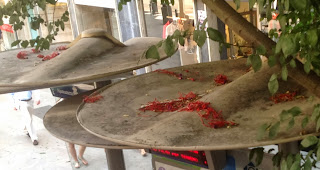 |
| Old ear phones |
So off we went on the red line heading in to the center of the city up the Passeig Gracia. The guide on the earphones spoke of some of the history of Barcelona. He then spoke about the Casa Batllo and the famous architecht from Barcelona, Antoni Gaudi.
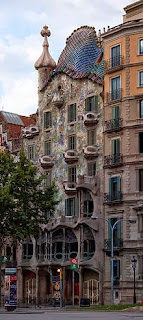 |
| Casa Batllo by architect Antoni Gaudi | |
|
Gaudi rebuilt this home in the affluent part of town in 1904 and it has been recently renovated for the benefit of the tourists. Gudi designed many of his buildings int eh Modernista style with undulating lines and decorative, sculpted stonework. This one has the facade completly decorated in broken ceramic tiles in colors of golden orange and greenish bues. The roof is a rounded hump of a dragon ending with a turret and cross which is symbolizing St George killing the dragon with his spier. St. George is the patron saint of Catalonia.
Other buildings around it give a sense of different architechtural styles.
We continue taking pictures of other architectural treasures. Here is one in a Baroque style
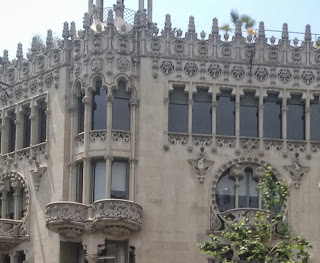 |
| Gothic Style |
We soon pass another Gaudi building with undulating floors. The balconies in a misshapen filigri style were designed by Josep Maria Jujol. It was the first building by the architect to have underground parking and separate lifts and stairs for the owners and their servants. It is now a museum where tourist can see the building inside. It was built for Roser Segimon and Pere Mila. Roser was a wealthy widow of Josep Gardiola who was a rich Catalonian who made his riches in the new world. When he died Roser maried Pere Mila who built this house for her. The residents of Barcelona ridiculed the building and joked that it looked like a quarry.
 |
| Casa Mila or La Pedrera (the Quarry) |
 |
| Inside atrium of Casa Mila |
 |
| Antoni Gaudi |
Gaudi's architecture is all over Barcelona. The most outstanding being the Basilica of Sagrada Familia which we planned to see the next morning.
We traveled up the diagonal avenue going west. This area is filled with more modern architechture like this building.
We soon passed a colorful mall.
We continued our tour arriving at the placa de Francesc Macia which is the main business section of the city. It is a large intersection named after a former president that promoted a free Catalonia.
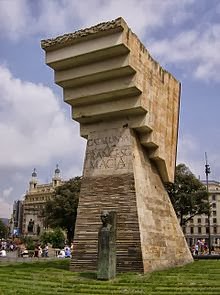 |
| Monument to Macia |
Rounding the corner we turned south west toward the Placa Espana Industrial where we were greated with a lovely park.
 |
| Placa Espana Park |
We cruised down past Joan Miro Park. He was a modern artist in the style of Surrealism who drew childlike drawings in pure simplicity.
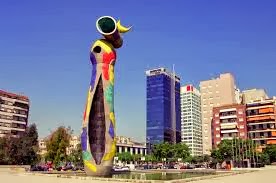 |
| Jean Miro park |
Soon we came at Placa de Espana which is another roundabout.
 |
| Round about at the Placa d'Espana |
 |
| This Colloseum ois mostly used for Soccor. |
This modern arena could be a smaller Colloseum with the arches over the windows and doors.
The Arena is at another end with the two towers facing the opposite direction.
We soon found ourselvs at the Magic Fountain of Montjuic in front of the national Museum of Art of Catalan.
 |
| Magic Fountain of Montjuic |
|
Across from the fountain we see the National Museum of Art of Catalonia. I would need a few more days to go through this museum. Alas, I leave it for another trip!
 |
| National Museum of Art of Catalonia |
Now we head up to the Mountjuic. Soon we see the Olympic spire, the symbol of the games of the Barcelona Olympics. I notice that John is now paying more attention as he looks around for playing fields.
We see the gondolas as they make their way to the top of the hill.
We stop at the building to buy tickets for the gondola. We can go down now or take the gondola up to the fort. We decide this is what we will do. So we get off and go to buy our tickets.
After buying a ticket we got in the gondola with a young German couple. The view from the window was a spectacular panoramic scene from above.
We could see why this city is the second largest in Spain after Madrid.
The gondola ride was a wonderful way to get to the fort. This is a high mountain that overlooks the city. It is called Montjuic or "Jew Mountain." A fortress was built here in the 17th century to overlook the harbor. As time went by, it was used to house garrisons and later political prisorners. The central area of the fort is the site of many executions.
In June 1792 the French astronomers Jean Baptiste Delambre and Pierre Mechain set out to measure the meridian arc distrance from Dunkirk to Barcelona, two cities lying on the same longitude and also longitude of Paris. The Fortress on Montjuic was chosen as the reference point in Barcelona. Using this measurement and the latitudes of the two cities they could calculated the distance between the North Pole and the Equator in classical French units of length and produce the first
metre which was defined as being one of ten millionth of that distance. The definitive meter bar was made of platinum.
When we came to a stop, we jumped out and made our way to the fort, and walked across the mote bridge.
 |
| Entrance to the fort. |
 |
| Manicured gardens at the fort. |
 |
| John entering the tunnel |
The fort was a solid fortification made of solid rock.
We walked up the steep path.
Coming out of the tunnel we found ourselves on the walk over looking the harbor. Large canons were still in place ready to defend the fort.
The view from the edge was spectacular. We could see the harbor with a large number of cargo sitting on the dock. We also saw our ship waiting for the next group of tourist to begin their trip back to Venice.
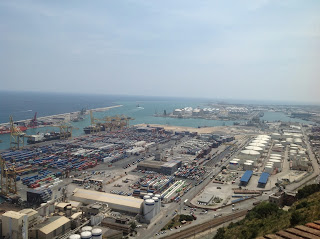 |
| Very busy harbor |
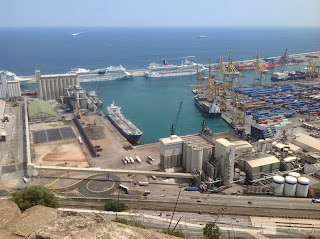 |
| The Carnival Sunshine getting ready to depart |
Over to the left we noticed a statue of a nymph overlooking the fort.
Near the building behind us a group of runners who decided not to take the gondola but instead ran all the way up the hill, decided to take a rest.
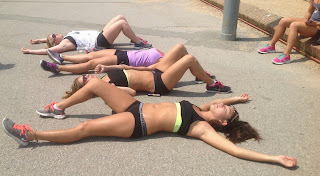 |
| Resting Runners |
We walked into the central plaza of the fort. Today many of the rooms are used as administrative purposes so there are people actually working in the buildings.
 |
| Central building |
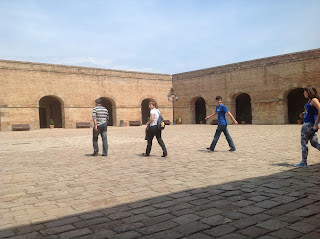 |
| Plaza were executions were held. |
|
We walked all around the building and found ourselves at the entrance once again.
The gondolas were still running so we waited our turn to get on one to return to the bus below.
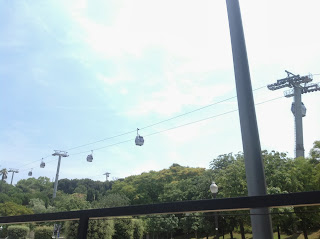 |
| Gondolas on their way |
Once on the gondola, I was able to take more pictures. John was looking for the Olympic stadium which was on the other side. The park was also built for the Summer Olympics which was a great success for the city of Barcelona in 1992.
 |
| View from the Gondola |
Down below we found our bus and left for the rest of our excursion.
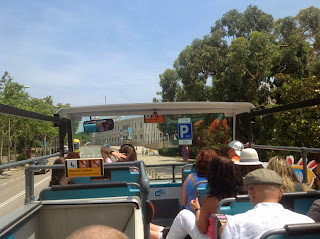 |
| Back on the bus to continue our sight seeing! |
We rode down the hill and got on the main road heading to the beach area.
Fancy street signs like this one were at every intersection.
Down by the pier we drove by the lovely yachts all in a row.
Some people found this was the place to disembark and threw their ear phones on the shade covers.
We circled around the statue of Columbus as he points to the new world and drove by the Maritime Museum
 |
| Stature of Columbus |
 |
| Maritime Museum |
|
|
There was quite a bustling crowd strolling by the beach.
We could see the beach as we drove by. John was ready to get out right there and I had to hold him back.
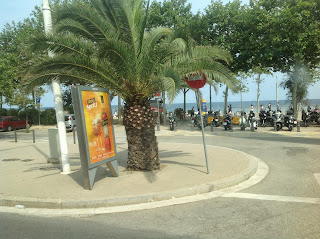 |
| The beach was so inviting! |
We circled around and then headed north back to the city. On the way we went by the park that was also the entrance to the Zoo.
Soon we saw the ancient building of the Castle of three dragons. It was built for the Exposición Universal de Barcelona in 1888 by Lluís Domènech i Montaner.
 |
| Castle of Three Dragons |
 |
| Here is one of the happy dragons! |
|
|
We finally came back to the Placa de Carolunya where we were to disembark. It was time to get rid or our earphones so we tossed them on to the shade umbrellas and that was that!

